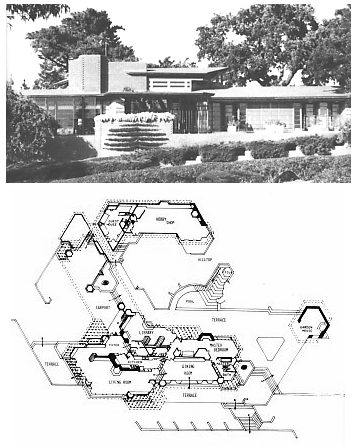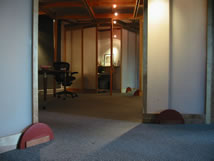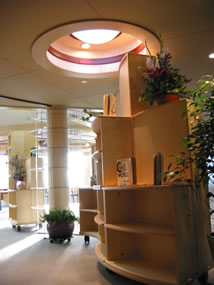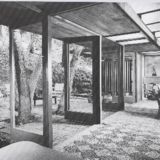|
In
1936, Frank Lloyd Wright developed a series
of homes he called “Usonian” [link].
Over about a 15 year period, he build a hundred
plus of these structures all over the United
States. The “prototype” to the Usonians
was the Willey
House [link] built
in 1934.
|
Willey
House builit 1934
phographed in 2000 by Lisa Piazza |
|
The
Jacobs house (shown in the above masthead
and below) was the first Usonian. It
was built for $5,500 including the architect’s
fee. Mr. Wright’s intent was to develop
a grammar and construction method for the
production
of simple, affordable, beautiful houses. In
recent years, these works have been the subject
of renewed study because they stand as eloquent
solutions to a most complex and elusive architectural
problem: the affordable single family dwelling.
|
Jacobs
House 1936
link to currant owner’s web site
|
|
Personally,
I consider the Usonian house - as a class -
to be one of the most successful examples of
the architectural art - and practice - in modern
times. These homes were simple: concrete floors,
natural wood walls, brick masonry piers and
fireplaces. Yet, they provided a vast variety
of different solutions and fit well into a number
of different settings and climes. They produced
a band of loyal owners unlike anything I have
seen since.
|
|
They
provided high quality environments for teachers,
writers, small store owners - average income
earners, who before, could not dream of owning
an architectural masterpiece.
|
|
The
first Frank Lloyd Wright house that I ever
experienced
was a Usonian - the Hanna House built at Stanford
University. Dr. Hanna devoted a large part
of
a Sunday morning, one spring day in 1953, to
showing me his house, describing his experiences
with Wright and how the house was designed
to evolve as his requirements changed over
the
years. This house evolved as the Hanna’s
requirements, lifestyle and income did. It
started
off as a “middle-class” dwelling
for a young family, and became, over a twenty
year period, a spacious, eloquent home for
a successful
professional couple. The first small Master
Bedroom became
the Hanna’s study; the three children’s
Bed Rooms morphed into a new Master Bed Room;
and the Family Room became a large formal Dining
Room for entertainment. A shop and garden
room was added as income allowed. All this
was accomplished with minor reconstruction;
the
entire scope of work having
been programmed, and structurally provided
for,
from the beginning.
|
|
This
introduction to Wrightian philosophy and work
totally mesmerized me.

|
Hanna “Honeycomb” House,
1938 |
|
The
Hanna House was built on an hexagonal module
that was scribed into the deep red, waxed concrete
floors. This was the first time that I was introduced
to the use of “Prospect” and “refuge”
in the creation of architectural space. Wright
was a master at this and could make the
smallest space both fit human scale and go on
forever. The house was not large but one space
flowed into another creating infinite variety
combined with the sense of pervasive shelter.
Being in the Hanna House is like living in a
forest - ever changing, minute to minute.
|
|
Professor
Hanna was clearly in love with his environment
which evolved with him and Mrs Hanna as they
raised a family and built individual careers.
I could see that it had become
an
integral
part
of their life and that living in it had deeply
effected their view of life. He talked
about the impact the environment had on
his
children as they were growing up. This morning
was a magical introduction, for me, to the
precepts
and reality of organic
[link] architecture.
|
|
During
my time at Taliesin, I was able to talk to many
owners of Usonians. They talked about their
environments with unreserved passion. It was
from one, Mrs. Pew, that I learned the true
secret of Mr. Wright’s genius and success.
|
|
She
described how, at first she hated the house.
She felt that Mr. Wright had not listened to
her requirements but merely built what he wanted.
She was, at the end of her second year living
in it, ready to sell it and move on - at great
financial sacrifice. She told me that she decided
that she would “give the house a year without
struggling with it” before she made up
her mind. In that year, a transformation took
place. She discovered that “Mr. Wright
had not built a house for who I was”
- but for “the person that I could become.”
“It turned out that Mr. Wright had listened
well and understood me very deeply.” “Now,
I can hardly stand to be in other people's homes.”
|
 |
NavCenters
apply Usonian principles to the workplace.
The AI WorkFurniture
grammar is a direct descendent of the way that
the Usonians were both built, structurally,
and furnished. This is extending the lessen
I leaned from Mrs Pew: that a way-of-living
can be expressed as a way
of working. These ideas are explored
in The Usonian Workplace [link].
The
typical North American home, today,
is bloated in size and nostalgic in
style. This is not affordable to the
individual family, nor over the long
run, to the planet. This housing has been kept in place by insane “creative financing,” short term “economics” and the determined effort to ignore social and ecological consequences. It is time for the concept of housing to be recreated. |
|
 |
| The
typical office environment is a strange combination
of cheap “rental” real estate [link] (where
most actually work) and grandiose flash
and blatant brand exploitation (in lobbies
and common areas) combined with the misapplication
and underutilization of modern technology [link].
It neither inspires nor augments knowledge
work [link]. |
|
|
I
spent an afternoon with Mrs. Pew in her
house,
in 1958, and consider that day to be one of
the seminal experiences in my development.
The
idea that an environment could facilitate
the evolution of a life was extraordinary in
its implications. It was not a great leap
from
this lesson to think of the environment facilitating
work; a “way of life” and a
way of working [link];
this idea of a transforming workplace
[link] is
just now, in 2004, finding a full expression
in built projects - prime examples of which
are the Vanderbilt Children’s Hospital
Executive Offices [link] (which,
unfortunately remained un-built) the
Collaboration Studio for masters Academy
and College [link] and
the World Economic Forum’s WorkPlace and
RDS [link].
|
| Stanley
and Mildred Rosenbaum built a Usonian in Florence,
Alabama in 1939. It was expanded in 1948
to accommodate
a growing family. The Rosenbaums lived in
the house until 1999 when the city of
Florence purchased it and restored it
by raising funds by a 1% sales tax (!).
Their son,
Alvin Rosenbaum [link] has
contributed a great
deal to the history of architecture [link] and
cultural connectivity and tourism [link].
The Rosenbaum family story
is a typical Usonian story.
These houses were not just abstract pieces
of art - they were environments based on
a concept of human potential and a-way-of-life
that seeks it. See my article
What Makes an Usonian a Usonian? [link] |
Usonian
Homes in Kalamazoo, Michigan |
|
These
Usonian Homes are scattered all over the
country
built by Mr. Wright and those who kept and
developed the tradition. There are a group
[link] of
them (mostly the concrete block variety)
in Kalamazoo, Michigan that I discovered
in
June 1999. I don’t (yet) know the whole
story of this development but a fast drive
by sparked
my interest. I understand that there is another
cluster of them just south of the city. [note:
here is a link to
information about the development - mt; 04/02/04]
|
| The
Roland and Ronny Reisley Usonian was build in 1951
in a Wright designed community in New York [link].
This development is probably the most successful
of several attempts on the part of Wright,
his clients and several apprentices to build
a sustainable community based on Usonian ideals.
The story is told well in a fasinating book
by Roland Reisley Usonia, New York:
Building a Community With Frank Lloyd Wright [link]. |
| For
an extensive online list of Usonian references
go to Answers.com [link]. |
a
house at Rush Creek Village |
|
There
were other architects and developers that
took
on this task of providing great works at low
costs. Bruce Goff [link] produced many successful
and
very unusual pieces in the 40s and 50s. Gordon
Drake had a brief, brilliant career after
World
War II. Architects Charles Eames [link] and
Raphael Soriano [link] explored
the possibilities of steel
and build surprisingly “warm”
structures with this difficult material.
|
|
 |
Goff
1952 |
Drake
1947 |
|
Architects
like John Lautner [link] carried on and build
an amazing number of works some of which
were
small
and
compact.
|
photograph © Judith
Lautner |
| The
Desert Springs Motel [link] is
a great retreat place [link] where
you can experience a Lauter environment [link]. |
|
The
Case Study houses sponsored by Art and
Architecture magazine
generated intense interest in small, affordable
houses [link].
|
| And
then, there was Rudolph Schindler without doubt
one of the most under-rated and greatest architects
of the 20th Century. |
Schindler
- Kings Row 1926 |
Schindler
- Pueblo Ribera [link] |
Schindler’s
Wolf House - late 1920s
photo © david leclerc
GoTo:
David’s story of the destruction of this
masterpiece
|
|
Rudolph
Schindler [link] built
a number
of wonderful and inexpensive homes in Southern
California during the 30s, 40s and 50s.
Schindler’s
own home predated much of the Unsion’s
grammar by nearly a decade. Along with him
was
Lloyd Wright [link],
another highly under rated genius. In the Bay
Area, there were a number of architects
that worked with great success: Wurster [link],
Bernardi and Emmons [link],
Jack Hillmer [link] and
Warren Callister [link] among
them. More
than any single architect that I can think
of, Warren gave fresh expression to the “bay
Area Style” [link] [link] started
by Maybeck [link] [link] (go
to [link] for
his materpiece) and others [link] at
the turn of the 20th Century.
|
Duncan Residence
by Warren Callester
|
Ludekens
House
by Jack Hillmer |
|
In
terms of volume, however, the developer
Joe Eichler [link] outpaced
them all.
|
|
I
met Eichler when I first moved to Palo Alto
in 1953 [link: 1953 and the tower]. His work and his passion for it impressed
me greatly. He took more joy in what
he was doing than any developer I have
met since.
One day, he gave my mother and me a tour of
several of his subdivisions. In retrospect,
what this man accomplished seems like a miracle
today. Joe Eichler built thousands of homes
in what, today, is Silicon Valley. They were
simple and were inspired by Frank Lloyd
Wright:
standard materials used well, privacy toward
the street, radiant floor heating, floor
to ceiling glass looking into
indoor/outdoor spaces, high open ceilings.
Although these Usonian principles were
used by Eichler,
he followed another architectural idiom: the
more casual California “post and Beam”
construction style. He hired, challenged and
turned loose a new generation of architects,
Anshen and Allen [link], and, A.
Quincy Jones [link] [link] among
them.
|
|
In
short time, a new framework was developed and
to this day “an Eichler” stands for
a distinct definition of lifestyle and architecture.
A book chronicling his many successes has recently
been published: Design for Living - Eichler
Homes (Chronicle Books, San Francisco) -
it is a fine tribute to one of the best developers
that ever worked.
|
|
Sadly,
these fine homes are now worth 500 to 750
thousand
dollars - or their land is - and they are being
decimated by inappropriate alterations and
additions,
and in many cases, being torn
down [link] to
be replace by bloated boxes of dubious character.
|
| For
a through review of Eichler’s work go to John
Fyten’s web site story [link].
This is one of the best overviews that I have
found. A number of Eichler related links can be found at Eichler Re-Mod - Adventures in DIY Remodeling [link: eichler.kimio.com]. |
|
No
matter their differences, what all these
architects, designers and developers
and their works have in common is a dedication
to building an environment based on a singular
view of human lifestyle: simple,
uncomplicated, natural, eloquent, affordable [link].
These are not “trophy” houses which
is why they are so vulnerable
today. All of these works sought to rethink
what a single family dwelling should be, and
together, constitute a movement that has come
and mostly gone but, I think, is returning
[link].
They flourished in an unique period of American
history and mostly, with the exception of
Wright’s
work, in an unique place: California. Their
basis was a notion of lifestyle
that stands, today, in sharp contrast to an
over-consumptive and compulsive culture.
|
|
In
a brief period of time - mostly three decades
- a complete cannon was laid down. I do not
know what is more surprising - that it was
done
in the first place or that, once accomplished,
so little remains of the practice today.
|
|
In
the 60s and 70s, there were several attempts
to revive this movement mostly driven by ecological,
energy and related issues. This included
a strong
do-it-yourself movement. To a great extent
this also has mostly faded. Unfortunately,
the affluence of the 80s, and 90s has not
been generally kind to the American landscape.
In the years that I first lived in Northern
and Southern
California
1952
to
1961), I used to go and visit these houses
and
wonder - I still wonder: what sparked their
creation, what allowed the majority of work
to go another
way despite their enduring popularity to this
day?
|
|
Today,
there are many branches of the Organic
School
of architecture. Bart Prince [link] who
has “inherited”
Bruce Goff’s work and the Jersey Devils
[link],
who design-build, are prime examples. Fay Jones
[link],
gone now, did wonderful work - mostly churches.
Arthur
Dyson [link] has
built a number of fine works in Fresno, California
and now is receiving very large
commissions. Here and there, all over the world,
great works
are
being created.
They
remain, however, out of the financial and organizational
reach of most people.
|
Arthur Dyson
LENCIONI RESIDENCE
1985 |
|
In
all, there are about a 100 or so architects
that consistently practice some variant of
Green or Organic Architecture many of whom
pay attention to
small and compact housing. The San
Francisco Institute of Architecture [link] and
the Frank
Lloyd Wright [link] School
of Architecture at Taliesin,
together, have an enrollment - at any given
time - of
about 100 students. This is out of a base of
about 80,000 plus architects practicing
in the
US. Given the scale of development and the
wealth in our society, the percentage of
truly fine
architecture - in proportion to what is being
built - is on the decline. On an absolute
measure,
I expect it is on the rise. Architecture that
can be considered “green” is
also an extremely small percentage of
the whole.
This is particularity true at the low end of
the building cost range. However, there
are places where building “green” is
becoming the standard. Sadly, however,
given the scale and scope of development,
green practices alone will not be sufficient.
We are, if we like it or not - recognize
it or not - entering into the era of planetary
architecture [link].
|
|
There
is little, in commercial housing today,
carrying the tradition of
the Usonian home, the Eichler house and the
many other post WWII examples. However,
in the realm of custom homes, there
are significant exceptions to the rule. Sarah
Susanka of Mulfinger, Susanka, Mahady and
Partners
and her associates are exemplars. She has co-authored
The
Not So Big House [link],
published by Taunton
Press [link],
and it is a feast for the eyes and soul.
The New Cottage Home by
Jim Toplin documents another path to simpler
living.
He has established a network [link]. The
insightbuilders website lists many
resources [link]. Recent
developments in cob, compacted earth and straw
bail housing, augmented with solar, abounds
- particularly in Northern California where
I
live [link]. Bahl Homes in Mountain View, California has build a number of modest size patio homes that reflect this philosophy [link:Bahl Patio Homes]. Below is a home they built in the early 70s.
|
| Here is a classic Usonian design and built by Tim Sutton for himself and his wife Marion in Ohio - it was completed in 2005. Click on the picture to go to a Gallery of this very well done project which illustrates many, many of the features of the Usonian ideal and way of living. Tim is a retired architect and this work shows his 50 plus years of experience in every detail. |
Thomas Tim Sutton, architect
Usonian Red House
started November 2002 completed january 2005 |
| This project is interesting in many ways. It is an extremely true rendering of a traditional Usonian while at the same time employing appropriate modern means and meeting contemporary requirements. As a 21st Century project, it shows that the Usonian concept is still viable and can be accomplished. I do not know details such as cost - these are things to hear about from Tim. His web site [link: usonian red house] walks you through the history of the project and provides a narrative about the experience of living in this superb environment. This is clearly a work which Tim wanted to do for most of his life. A great deal of care and passion went into this piece. It is good to see it done. As I note often in my architecture Notebooks [future link], one of the most disconcerting aspects of architecture today is it loss of material quality. The Usonian Red House is a reminder of what can be done with basic materials and the sense of place which can be made by their proper employment. |
|
Affordable
domestic architecture [link] remains
one of the great challenges facing architects.
The need for the recreation of this body of
work has never been greater nor have the opportunities
been better. This issue has to be placed back
on the designer’s agenda and the solution
will surly evolve only out a close integration
of the Design-Build/manufacture-Use
process [link].
You cannot build affordable housing if over
50% of the cost and 65% of the calendar time
invested is non-value added waste.
This is a ValueWeb
[link] and
supply-chain challenge.
|
|
A
better method of building is required and
and
new method of contracting, financing and selling
is necessary. A new practice
model [link] is
required. The housing industry is dominated
by
UpSideDown Economics [link] -
this fact drives the design process more than
any other single
factor. Structure wins. The entire real
estate development and management process
[link] has
to be re-created - it is broken
[link] now.
|
|
However,
new methods
[link] of
designing and building and new methods
of organization can combine to bring great
architecture
back to a far larger number of our population.
Re-integration of design/build is a start.
Chandler Construction [link],
among others, is doing this. There is no excuse
for ugly, energy inefficient,
ecologically
taxing, lifestyle impoverishing buildings -
no matter what the budget demands are. Green
building [link] is
necessary - and possible.
|
|
For
some of the problems associated with affordable
housing to be solved, new codes (and a new
non-government code method), development
practices
and building types will be required. Communities
and community
living [link] will
have to be reintroduced. Ken Norwood (Rebuilding
Community in America)
of the Shared Living Resource Center in Berkeley,
California (800 475 7572) has explored
this
ground.
|
|
The
postUsonian Project will look at
the entire structure, technology and process of
creating, owning and living in the basic
home.
It will “go back” to the earlier
work and start a new evolution from these
successful
beginnings. It will assemble a new society
of
“cathedral-builders”
[link] dedicated
to the creation and practice [link] of
daily life as a “living art.” This
will require a ValueWeb
[link] devoted
to this challenge. It will follow the general
process of the “swimming pool method” [link] I
pioneered in the 60s. This
will be a design-build-use
[link] practice
that draws on what has been learned, at
MG Taylor, in the realm of workplace creation. It
is not too soon to start building this WEB.
Anybody interested? This is a serious question.
Who is ready to begin?
|
April
25, 2004:
A
blog has been set up to create a
ValueWeb capable of recreating the
Usonian concept - if you are ready
to act, join the BLOG [link],
add your thoughts and/or email [link] me.
Four
projects, that in one way or another
will advance our knowledge and capability
are being prepared for prototyping
[link].
And
now (2005), a fifth one - not a Usonian
but a project that will prototype
many useful building techniques [link].
|
|
| One
comment that Mr. Wright made again and again
was “until we have an organic culture
we will never have an organic architecture.”
His point is that architecture is the result
of the choices individuals make and it expresses
the culture they make up and in turn are influenced
by. The Usonian house is not just another way
to
“style”
a
building
- it is about a different way of living; a
way that, today, is alien to the mainstream
of our American culture. The usonian
way is about relating differently
to the Earth, to life and to all living beings
- it is an integrated, natural life-style.
Sustainable, evolving, sensory, engaging -
it is to be surrounded by beauty and to live
in
harmony. |
|
|
|
| Return
To postUsonian Project Index |
|
|
|
|
| Return
To post Usonian Prototypes |
|
|
|
|
| Return
To Usonian Reading List |
|
|
|
|
| GoTo:
Bay Area Studio for Matt Taylor |
|
|
|
|
| GoTo:
Domicile One - CoHousing Alternative |
|
|
|
|
| GoTo:
Gail’s Nest - Sheet PD 1 |
|
|
|
|
| GoTo:
Planetary Architecture - The Case |
|
|
|
|
| GoTo:
Sealoft for Matt & Gail Taylor - 1991 |
|
|
|
|
| GoTo:
ValueWeb Architecture |
|
|
|
|
| GoTo:
WorkConservatory - April 04 Update |
|
|
Matt
Taylor
Palo Alto, California
March 4, 1999 |
|
|

SolutionBox
voice of this document:
INSIGHT • POLICY • PROGRAM
|
posted
March 4, 1999
revised
August 7, 2005
• 200000123.75137.mt • 20000527.93611.mt •
•
200020912.124155.mt • 20011206.356711.mt •39871.mt •
• 20020930.209981.mt • 20040312.345187.mt •
• 20040316.451988.mt • 20040402.243171.mt
•
• 20040403.600081.mt • 20040425.548900.mt •
• 200406
23.450000.mt • 20040920.669123.mt •
• 20041003.511100.mt • 200412
29.878712.mt •
• 20050713.544512.mt • 20050807.123456.mt •
• 20050915.222201.mt •
(note:
this document is about 99% finished)
Copyright© 1999,
2000, 2002, 2004, 2005 Matt Taylor
|